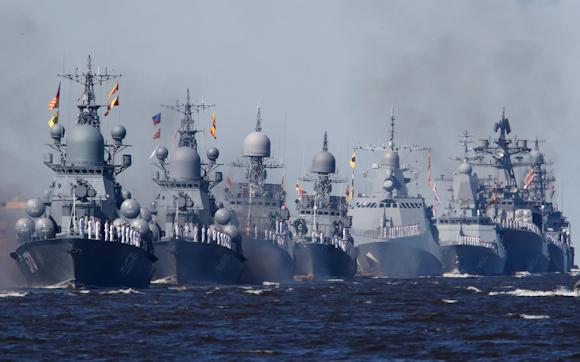As a result of the crises of recent years, all the factors that have contributed to the progressive deterioration of relations between Russia and the West have come to light. First of all, Moscow's distrust of a West perceived as a threat that involves not only the military sphere, but also the cultural and value one. Secondly, the belief that Washington is deliberately imposing an anti-Russian strategy on Europeans as well, with the aim of weakening and isolating the Eurasian giant, sabotaging the possibilities of a collaborative relationship between Brussels and Moscow and keeping the European Union firmly in place. American orbit.
Added to this is the European distrust generated by the ruthlessness with which Putin acts to make Russia recover the influence lost with the dissolution of the Soviet Union, in an attempt to rebuild an equal relationship with American power. An antagonism that has recently found its place in the world media, following the strong statements of President Biden, who called the Russian leader "murderer", provoking his immediate reaction with the recall to Moscow of the ambassador in Washington "for consultations" and the summoning of the US ambassador.
Events that reawaken the never completely dormant rivalry between the two powers and that do not help to calm the international political climate that suddenly, despite the arrival of spring, found itself recording Cold War temperatures.
The Russian maritime strategy
 Russia today is a European country that looms with its political, military and energy force over the entire Old Continent. A country that has always been attentive to events in the Middle East and with historical interests in the Euro-Mediterranean area, all the more so after the re-appropriation of Crimea, considered a springboard for expansion towards the Mediterranean, Red Sea and Persian Gulf basins. Add to this the fact that Russia is also an Asian and Pacific power. All this, combined with its considerable resources in the energy field and relevant capabilities in the nuclear and missile sectors, allows Russia to tenaciously pursue the goal of returning to the greatness of global power.
Russia today is a European country that looms with its political, military and energy force over the entire Old Continent. A country that has always been attentive to events in the Middle East and with historical interests in the Euro-Mediterranean area, all the more so after the re-appropriation of Crimea, considered a springboard for expansion towards the Mediterranean, Red Sea and Persian Gulf basins. Add to this the fact that Russia is also an Asian and Pacific power. All this, combined with its considerable resources in the energy field and relevant capabilities in the nuclear and missile sectors, allows Russia to tenaciously pursue the goal of returning to the greatness of global power.
To achieve this goal, after the very serious crisis it went through in the 90s and early years of this century, in the last decade Moscow has embarked on an important phase of modernization and reorganization, starting with its naval strategy, updated in July 2016.
According to what reported by Center for International Maritime Security of Washington (CIMSEC), the document defines the role of the Navy in the broader framework of the Moscow security strategy up to 2030, describing the growth objectives of the naval forces, the geographical areas of interest and the threats which it will be expected to face, identifying the main adversaries in the United States and NATO navies, however, admitting that these are equipped with more technologically advanced fleets and equipped with high-precision armaments1.
In this context, Russia believes that its warship Navy in the short term will not be able to have the same fighting capabilities as its opponents and recognizes, in particular, the technological primacy of the US Navy, admitting that Russian plans do not foresee the construction of a fleet of the same qualitative and quantitative level.
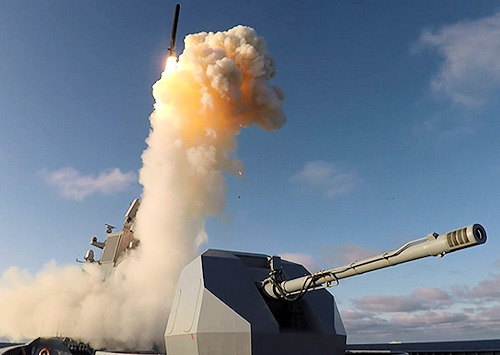 The Russian Navy would be assigned "... four main missions: the defense of the Russian coasts and its maritime borders, the long-range precision attack with both nuclear and conventional weapons, the projection of power by means of the underwater fleet and the nuclear deterrence at sea with its submarines with ballistic missiles ... "2.
The Russian Navy would be assigned "... four main missions: the defense of the Russian coasts and its maritime borders, the long-range precision attack with both nuclear and conventional weapons, the projection of power by means of the underwater fleet and the nuclear deterrence at sea with its submarines with ballistic missiles ... "2.
The part of the document that attracts the most attention is the identification of the areas of strategic interest of the Russian fleet, i.e. where a significant and permanent presence of its military deterrence units is expected: Arctic Ocean and Sea of Okhotsk (intended as strategic fortresses from which to monitor the Atlantic and Pacific Oceans), the Black Sea and the Mediterranean.
As in the time of the Cold War, therefore, the Russian Navy today wants to assume a posture addressed to theanti-access and area denial (A2 / AD) to ensure deterrent power against other naval powers. This is more or less the same approach maintained since 1975, when the Soviet (essentially Russian) fleet as a whole applied the theory that some have called "bastions", which consisted of concentrating nuclear submarines with ballistic missiles in two. specific areas close enough to the motherland to have security coverage by underwater vehicles, the surface fleet and land-based naval aviation, but positioned in such a way as to be able to validly oppose Western fleets and be effectively employed as nuclear retaliation against US objectives, in the event of an attack by the opponent.
For the Atlantic Ocean such was the bastion under the cold waters of the Arctic. That ocean was, in fact, a safe haven natural stretch for 14 million sq km, one sixth of the Atlantic, with a depth of about 4.000 m although in the Bering Strait, its only passage for the Pacific, the maximum depth is only 55 m. A privileged parking place for boats destined for nuclear deterrence as the deep sea beds offered an ideal refuge and the pack ice protected the submarines from satellite surveillance. An area located at a safe distance from NATO's imaginary naval barrage, known as GIUK (English acronym for Greenland, Iceland, United Kingdom).
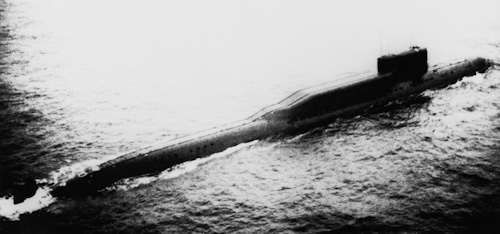
For the Pacific, the area chosen as a bastion was that of the waters of the Sea of Okhotsk, between the Kamchatka Peninsula, the Kurili Islands, the Japanese island of Hokkaido and the island of Sakhalin.
At the time, such a posture could make use of two important tools: long-range ballistic missiles and “Delta” class submarines (NATO denomination), capable of carrying and launching them in a covert manner, while remaining submerged (photo). These two elements allowed the Russian Navy to keep its deterrent fleet in a theoretically impenetrable defense position, the ramparts.
A posture that ensured mutual destruction but that left Western analysts perplexed, undecided whether to consider it a move aimed at preserving the safety of the underwater fleet (damage limitation strategy) or whether, instead, it was a choice intended "only" to prevent the approach of opponents to the Russian / Soviet coasts (strategy now known as deny access). Whatever the original motivation was, it is now known that US submarines managed to penetrate the Soviet bastions several times, managing to gather valuable information thanks to secret operations such as, for example, the "Ivy Bell" operation conducted under the waters of the Sea of Okhotsk from a submarine, theUSS Halibut, which went down in the history of underwater espionage.
According to what emerges from the latest Russian document, therefore, Moscow would not have abandoned the strategy of the ramparts even after the end of the Soviet empire, remaining even today one of the fundamental points of nuclear deterrence against Washington or anyone who threatens Russian territory. This would confirm what Michael Kofman, an American analyst specializing in Russian affairs, wrote in a 2017 article where, in fact, he states that "... the Russian Navy is not designed to compete with the US Navy but, rather, to counter it by supporting the XNUMXst century Eurasian land power strategy ..."3.
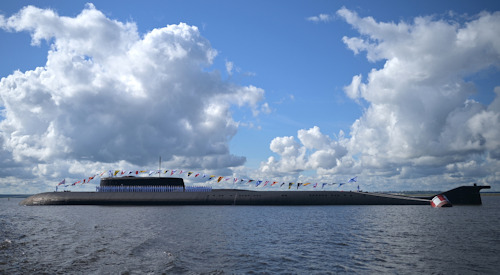 Russian air and naval devices
Russian air and naval devices
All in all, when compared to the past, today's Russia is considerably less powerful than the Soviet Union of the Cold War period, even though its Armed Forces have remained sufficiently capable of causing substantial damage in the event of an eventual armed conflict. . In this strategic context, the Navy plays an important role and should not be underestimated, despite the persistence of some gaps and the consistent "weight loss" treatment. In 1989, in fact, the Soviet bloc could count on a total of 62 ballistic missile submarines (SSBN), 66 cruise missile submarines (SSGN) and more than 200 multipurpose attack submarines. Today, however, Russia has "only" 10 SSBNs in service, defended by a relatively weak device of surface units and multi-purpose submarines4.
However, the substantial investments made by Moscow since 2010 are starting to bear fruit, such as with the R-30 ICBM. "Bulava" (NATO code SS-N-32), derived from "Topol-M" deeply revisited, embarked on XNUMXth generation “Borei” class submarines. The first unit of the class, the Kyniaz Vladimir, entered service in June 2020. The planned eight units of this class will each carry sixteen missiles, each of which will contain up to ten independent multiple nuclear warheads (Multiple Independently targetable Reentry Vehicles - MIRV). The maximum range of the "Bulava”Is estimated at about eight thousand kilometers.
A further qualitative leap will take place with the entry into service (scheduled for 2023) of the hypersonic anti-ship missile "Tsirkon" (photo) which, in the intentions of Moscow, should mainly constitute the other fundamental element of the defense of the ramparts. The new weapon would then have the possibility of being embarked on many surface and underwater units. This would give them the ability to respond to any attacks by hitting targets on sea and land at distances up to 1.000km at short notice given the claimed speed of Mach 9.5.
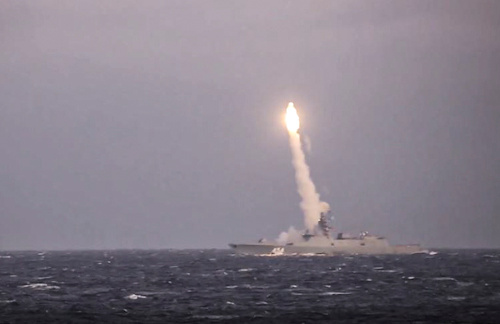 Meanwhile, studies have already begun for a fifth generation submarine, flexible enough to be able to launch future ballistic or cruise missiles.
Meanwhile, studies have already begun for a fifth generation submarine, flexible enough to be able to launch future ballistic or cruise missiles.
But, as can be easily understood, the defense of the ramparts also makes use of other tools, besides the underwater fleet and hypersonic missiles, which still represent the most significant elements.
The Northern Fleet, for example, whose Command is based in Severomorsk (Kola peninsula), is numerous but with drastically reduced operations after the collapse of the USSR, also due to the rigidity of the weather conditions which require frequent maintenance operations. , raising management costs. However, due to the substantial funding of the last decade, operations are gradually improving, hand in hand with the increase in the efficiency of vessels. The flagship of the Severny flot is the only operational aircraft carrier of the Russian Navy, theAdmiral Kuznetsov, of 45.000 t.
The Pacific Fleet, whose Command is based in Vladivostok, currently has about 60 ships of various sizes and an amphibious assault component. To try to live up to the competition that is taking place in that chessboard, Moscow has launched a renewal program which, in a reasonably short time, should allow about 20 technologically advanced ships to be added to the fleet. The flagship is the 11.500t Missile Cruiser "Varyag" (NATO class name "Slava"), entered service in 1989, capable of carrying 120 missiles.
For the anti-submarine fight, the Russian Navy aviation basically has three patrol models, all technologically dated, available in limited numbers and with outdated performances. This is the "Ilyushin-38", a four-engine turboprop whose design (based on the Il-18 passenger aircraft) dates back to the 60s, used by Aviation Voenno-Morskogo Flota (AV-MF) but with too limited range of action for an operational use far from the Russian coasts. Today the Il-38N is in service, a modernized version of the aircraft, which is also operational in Indian naval aviation. The second model is the "Tupolev-142MK / MZ" (known in NATO as "Bear F / J"), a long-range patrol vessel dating back to the 70s and derived from the Tu-95 strategic bomber, available in about thirty specimens, divided between the Northern and Pacific Fleets.
 The third model of maritime patrol boat is the seaplane "Beriev-12N Čajka" (Seagull) (known in NATO as "Mail"), also dating back to the 60s, first withdrawn from service and then reinstated in the aftermath of annexation. of Ukraine in 2014 and now serving in the Black Sea Fleet.
The third model of maritime patrol boat is the seaplane "Beriev-12N Čajka" (Seagull) (known in NATO as "Mail"), also dating back to the 60s, first withdrawn from service and then reinstated in the aftermath of annexation. of Ukraine in 2014 and now serving in the Black Sea Fleet.
Other more modern patrol boat projects are being studied but, according to the newspaper Izvestia in January 2020, the new "Tu-204P" antisubmarine patrol vessel (derived from the Tu-204/214 airliner), will not be available before 2030. News that, however, has not been confirmed by the Russian Navy. As reported on the site redsamovar. com, the aircraft would present interesting solutions regarding electronics and discovery apparatuses and should be equipped with four anti-ship missiles "Zvezda Kh-35U" (NATO code AS-20 “Kayak”), nicknamed "Harpoonski" because of the similarity with the American missile "Harpoon".
By 2030, therefore, Russia should be equipped with numerous ultramodern submarines but protected by fairly outdated naval aviation, despite the planned modernization of the air fleet. Nonetheless, as James Lacey, a strategic studies specialist at the Marine Corps War College in Quantico (Virginia), this will not particularly affect the strategy of the ramparts as "... the ramparts of the north of Russia will still be the strategic center of the country, to ensure the influence of Moscow on the Arctic, rich in resources ... Further south, Moscow seems to want to make the Black Sea a Russian lake and the Crimea a military bastion capable of assuming an aggressive posture to dominate the surrounding waters ... "6.
The Black Sea and the Mediterranean
And here the discourse calls into question the waters closest to us. In recent years, in fact, the presence of the Russian Navy in the Mediterranean has considerably increased, a first visible effect of the new maritime posture of Moscow and the parallel progressive decrease of the US naval presence. In fact, started under the Obama administration, the American retreat became more intense with President Trump, justifying this reorganization of the fleets with the need to ensure a greater American presence on the Indo-Pacific theater, to face the growing threat represented by an arrembante China and from an insidious North Korea. However, this strategic repositioning has caused a progressive increase in instability in the Mediterranean, as ample room for maneuver has opened up for the more enterprising Navies, which have begun to assume an extremely assertive posture.
 Russia, therefore, has done nothing but take the opportunity to return to the Mediterranean, where the Syrian and Libyan crises have provided further reasons for expansion and the opportunity to return to play an important part on this fundamental chessboard, while at the same time seeking to make people forget the Ukrainian events. In this sense, the new maritime posture and the renewed Russian naval presence in Syria must be read. With its very determined intervention in Syria, in fact, Russia wanted to send a clear signal to the world that it wanted to once again tread the international stage as an essential actor for the solution of the main planetary issues. In essence, the renewed Russian presence in Syria represents the means by which it is implementing its maritime strategy in the former "Mare Nostrum". A maritime strategy that must be considered the spearhead and qualifying element of a broader strategy.
Russia, therefore, has done nothing but take the opportunity to return to the Mediterranean, where the Syrian and Libyan crises have provided further reasons for expansion and the opportunity to return to play an important part on this fundamental chessboard, while at the same time seeking to make people forget the Ukrainian events. In this sense, the new maritime posture and the renewed Russian naval presence in Syria must be read. With its very determined intervention in Syria, in fact, Russia wanted to send a clear signal to the world that it wanted to once again tread the international stage as an essential actor for the solution of the main planetary issues. In essence, the renewed Russian presence in Syria represents the means by which it is implementing its maritime strategy in the former "Mare Nostrum". A maritime strategy that must be considered the spearhead and qualifying element of a broader strategy.
In this context, the agreement signed between Moscow and Damascus in January 2017 for the use of the naval base of Tartus and the Khmeimimm air base for a period of 49 years, automatically renewable for another 25 years, must be seen. Port of Tartus, a support point for Moscow ships since 1971, now capable of accommodating up to 20 naval units and also providing specialized technical assistance, the S-300 advanced anti-aircraft missile systems have been added along the Syrian coast (also purchased from Turkey), and missile systems "Pantsir" (known in NATO as SA-22 systems "Greyhound"), short and medium range, of supersonic anti-ship missiles "Yakhont" (also known as P-800 "Oniks" or SS-N-26 "Strobile"), short-range hypersonic tactical ballistic missiles "Iskander" (NATO code SS-26 "Stone"), as well as long-range electronic surveillance systems and advanced electronic warfare systems. Combat aircraft and helicopters were then deployed at the aforementioned Khmeimimm air base (near Tartus), with the task of constituting a protective umbrella for Russian naval operations7. Russia can also count on the availability of a certain number of secondary springs along the southern coasts of the basin, such as Alexandria in Egypt and Algiers. Not to mention the ports of Cyrenaica, the spearhead of Russian penetration in the central Mediterranean, a few miles from our coasts and from the naval bases of Sigonella, Augusta and Catania.
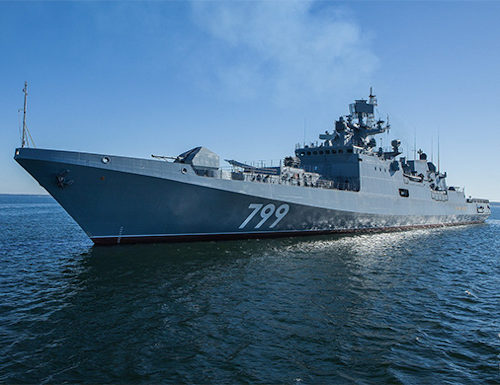
At the moment, the overall Russian consistency in the Mediterranean waters does not require other large ports of the type of Tartus but, given the growing influence that the Russians are assuming in the Libyan area and the importance that Moscow assigns to maintaining that position (even in a penetration into the African continent) it is not excluded that, once the presence on the coasts of Sudan is consolidated (a new naval base with a capacity of four surface units and a total of about three hundred personnel), the eastern coast of Libya will not become object of greater attention also in terms of the expansion of military port and airport infrastructures, such as Tobruk, Derna, Sirte and al-Ğufra, which could assume the same importance as Tartus in the future.
Ultimately, the Russian presence in Cyrenaica, so close to our coasts, appears quite worrying both because it is a country whose missile armament is capable of threatening our coasts and because, unlike the Turks (whose Navy has so far benefited most of all by the US disinterest in our waters and which is applying a rather aggressive maritime policy), the Russians are less "bloodthirsty" in reactions but potentially much more dangerous as they are able to express a wide-ranging strategic vision and much longer term, not being driven by the passions or needs of the moment.
As underlined by Rear Admiral Domini, of the Center for Studies of Geopolitics and Maritime Strategy (CESMAR), in the current situation of fierce international competition for the exploitation of marine resources, it will be essential to have eyes to see and ears to hear, maintaining a qualified naval presence in the waters of the eastern and central Mediterranean, with ships that are also capable of carrying out the necessary deterrent action against any initiatives aimed at restricting our freedom of use of the sea.
Conclusions
Since the second half of the XNUMXs, just after the Second World War, two opposing interpretations of the relationship of the West with the then Soviet Union have been confronted. On the one hand there were those who saw in the USSR, an entity dominated by Russia, the prophet of the world revolution, with whom any dialogue would have been impossible. On the other hand, those who tended to reduce the weight of ideology and to consider the USSR a great traditional power, interested in making every possible profit from the international order rather than overthrowing it. Now that the ideological prejudice has - or should have - disappeared, the question remains of how to set up relations with a Russia that with ever greater determination pursues the objective of recovering a prominent role within the international scenario.
 At the basis of the current Russian attitude remains the painful trauma that represented the collapse of the Soviet Union, an Empire built with immense sacrifices over the centuries but which dissolved in a few hours. A trauma that made a young Putin, who has just come to power, declare that he wanted to restore "its greatness" to his country. In fact, on the horizon he also saw the danger that on the geopolitical level Russia would be reduced to an average Asian power, squeezed between China, a more dynamic power which had already surpassed Russia on the economic and demographic level, and which today seeks to overcoming it even under the military one, and a Europe that had regained its unity up to the eastern borders of Poland and Finland and that has incorporated many countries of the former Warsaw Pact into NATO.
At the basis of the current Russian attitude remains the painful trauma that represented the collapse of the Soviet Union, an Empire built with immense sacrifices over the centuries but which dissolved in a few hours. A trauma that made a young Putin, who has just come to power, declare that he wanted to restore "its greatness" to his country. In fact, on the horizon he also saw the danger that on the geopolitical level Russia would be reduced to an average Asian power, squeezed between China, a more dynamic power which had already surpassed Russia on the economic and demographic level, and which today seeks to overcoming it even under the military one, and a Europe that had regained its unity up to the eastern borders of Poland and Finland and that has incorporated many countries of the former Warsaw Pact into NATO.
In this context, if the US withdrawal from the Mediterranean precludes a progressive disengagement from the European territory as well, we would be faced with an enormous strategic error. As early as July 2009, in the aftermath of the Georgia crisis, a group of leading politicians from Central and Eastern Europe, including Lech Wałęsa and Václac Havel, and former presidents of Lithuania, Romania, Slovakia and Latvia, in fact, stated that “… Our region is one of those that the Americans seem to have stopped worrying about, considering it now definitively stabilized. This conclusion is premature. Our hopes that relations with Russia could improve and that Moscow would accept our sovereignty and independence have not come true. On the contrary, Russia has returned to being an expansionist power with a nineteenth-century program, but twenty-first century tools and methods ". Under these conditions, the appeal of Central European leaders continued, "Only a more decisive and principled policy can induce Moscow to follow a policy of cooperation ...".
The recent, not very diplomatic and in some ways "clumsy" stance by Washington seems to want to respond to this need. Meanwhile, Europe does not appear to have a long-term strategy, limiting itself to criticizing the Kremlin about Russian actions in Ukraine and stigmatizing the failure to investigate the murders of journalists and opponents, while declaring that the relationship with Russia is and remains crucial for Europe.
Having given up, for a thousand reasons, not least the economic one, to contend for American supremacy in the open sea, Russia has therefore adopted a defense strategy that has made the Mediterranean its third bastion. Favored by a substantial absence of European politics (to which Russia assigns little importance, as demonstrated by the failure of the visit to Moscow by Josep Borrell, High Representative for the CFSP) and by the growing US military distraction of the latest administrations, Moscow is expanding its its influence throughout the area. The presence of small but powerfully armed surface units with missiles capable of striking at a great distance and the ease with which Moscow is moving allows the Russians to "control" the area with discretion, to consolidate their alliances in the basin and to lay the foundations for strategic penetration in the African continent, rich in resources. A much more problematic strategic penetration, if projected in the long term, than the Turkish posture started with the Mavi vatan.
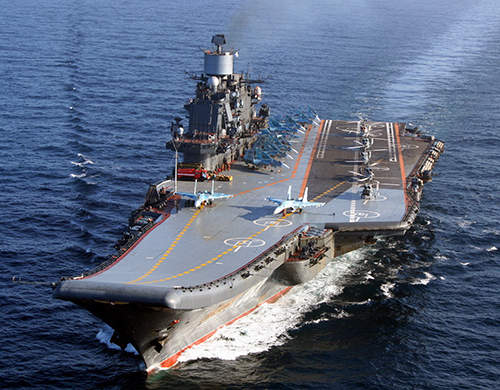
How can we forget the aircraft carrier's demonstration of power "Admiral Kuznetsov" (photo) which, escorted by a large task force (and certainly from submarines), it was a platform from which numerous air missions left to hit targets on Syrian territory. A presence that underlined the Russian ability to project power and Moscow's desire to return to being an influential and decisive geopolitical subject in the Mediterranean area, and beyond.
This is the reason why the operational approach to present and future crises cannot ignore the study and understanding of contemporary Russian military strategy, whether Moscow confirms itself as a traditional adversary of the West, or becomes a potential ally of the West. anti-jihadi.
Basically, as Sun Tzu teaches us, we must not be afraid of the Russian Navy, but we must know our potential adversary well and respectfully analyze what Moscow is trying to achieve with its air and naval fleets they represent, like all navies in the world. , an indispensable tool of foreign policy and qualifying elements of a broader overall strategy. As Michael Kofman wrote “… The inability to understand the opponent's potential and the logic that guides his moves is an excellent method to remain, someday, unpleasantly surprised. Learning (too late) from that type of experience usually causes loss of life ... "8.
1 Eyal Pinko, Russian Black Sea fleet activity in the eastern Mediterranean Sea: implications for the Israeli Navy
2 Michael Kofman, Because the Russian Navy is a more capable adversary than it appears, on Nationalinterest.org, 22 August 2017 "The Russian Navy is coalescing around four principal missions: defense of Russia's maritime approaches and littorals, long-range precision strike with conventional and nuclear weapons, power projection via the submarine force, and defense of the sea-based nuclear deterrent carried aboard Russian SSBNs. "
3 Michael Kofman, Because the Russian Navy is a more capable adversary than it appears, on Nationalinterest.org, 22 August 2017 “The modern Russian Navy is not designed to compete with the US Navy, but instead to counter it, and to support the strategy of a twenty-first-century Eurasian land power”.
4 Michael Kofman, It's time to talk about A2 / AD: rethinking the Russian military challenge, on warontherocks.com, September 5, 2019 “Consider that in 1989 the Soviet Union fielded 62 ballistic missile submarines, 66 guided missile submarines, and over 200 general purpose attack submarines. Today Russia fields only 10 ballistic missile submarines, defended by a relatively small force of surface combatants and general-purpose submarines in its primary fleets. "
5 Paul Bernsteni and Harrison Menke, Russia's Hypersonic Weapons, Georgetown Journal of International Affairs, 12 December 2019. News also taken up by the Center for the Study of Weapons of Massa Destruction on 13 December 2019
6 James Lacey, Battle of the bastions, on warontherocks.com, January 9, 2020
7 Eyal Pinko, Russian Black Sea fleet activity in the eastern Mediterranean Sea: implications for the Israeli Navy
8 Michael Kofman, Because the Russian Navy is a more capable adversary than it appears, on Nationalinterest.org, 22 August 2017 “Failure to understand an adversary's capabilities, and the logic behind them, is a good way to someday become unpleasantly surprised by them. Learning from that kind of experience usually comes at the expense of lives. "
Photo: MoD Russian Fed. / Web

